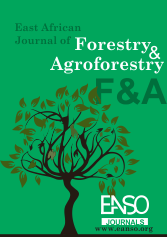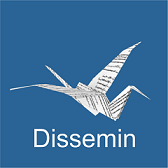Synthesis of Deforestation and Forest-Based Climate Change Mitigation Strategies in Ethiopia: Review
Abstract
Despite diverse ecosystems and rich biodiversity, Ethiopia faces severe environmental challenges, including deforestation, land degradation, and climate variability and change. In Ethiopia, the forest cover dramatically decreased from 40% in the 19th century to 3% in 2000, largely due to agricultural expansion, population growth, and weak forest governance. Deforestation not only threatens biodiversity but also exacerbates the country's climate vulnerabilities, which is heavily dependent on rainfed agriculture. This study provides an overview of deforestation and forest-based climate mitigation strategies in Ethiopia. The review comprehensively examined over 80 documents, including peer-reviewed journal articles, MSc theses, reports, and policy documents from 2002 onwards. The findings revealed that the deforestation rate decreased by 69.8% from 2000 to 2023. This indicates that forest conservation strategies have been implemented. Ethiopia recently practised different forest-based mitigation strategies, including forest conservation, afforestation and reforestation, REDD+ programs, and agroforestry expansion for increasing forest cover and decreasing the adverse impact of climate variability and change. As a result, the forest cover has increased from 17.2% in 2019 to 23.6% in 2023. Despite significant efforts in the country, institutional weaknesses, political instability, land tenure insecurity, and inadequate policy enforcement continue to hinder sustainable forest management and development. We conclude that deforestation has been reduced significantly in Ethiopia. To strengthen forest-based mitigation efforts, the study recommends improving institutional coordination, enforcing environmental policies, enhancing community engagement, and ensuring data accessibility
Downloads
References
Alemie, Berhanu Kefale, and Tadesse Amsalu. 2020. “Does Land Tenure Insecurity Affect Forest Cover Change ? Evidence from Gerejeda State Forest in Ethiopia.” Journal of Land and Rural Studies 8(2):1–20. doi: 10.1177/2321024920914781.
Asefa, Mengesha, Min Cao, Yunyun He, Ewuketu Mekonnen, Xiaoyang Song, and Jie Yang. 2020. “Plant Diversity Ethiopian Vegetation Types, Climate and Topography.” Plant Diversity 42(4):302–11. doi: 10.1016/j.pld.2020.04.004.
Belayneh, Yigez, Guo Ru, Awoke Guadie, and Zebene Lakew Teffera. 2018. “Forest Cover Change and Its Driving Forces in Fagita Lekoma.” Journal of Forestry Research 31:1567–1582. doi: https://doi.org/10.1007/s11676-018-0838-8.
Betru, Teshome, Motuma Tolera, Kefyalew Sahle, and Habtemariam Kassa. 2019. “Trends and Drivers of Land Use / Land Cover Change in Western Ethiopia.” Applied Geography 104(August 2018):83–93. doi: https://doi.org/10.1016/j.apgeog.2019.02.007.
Beyene, Abebe D., and Arega Shumetie. 2023. Green Legacy Initiative for Sustainable Economic Development in Ethiopia. Policy Working Paper 10/2023. Ethiopian Economics Association (EEA). Https://Eea-et.Org/Wp-Content/Uploads/2023/02/WP-10-2023.Pdf.
Bhatt, Ganesh Datt, Yamuna Expressway, Greater Noida, and Uttar Pradesh. 2019. “Cause, Impact and Remedy of Deforestation in Ethiopia.” Journal of Emerging Technologies and Innovative Research (JETIR 6(1):53–56.
Birhane, Emiru, Mehari Alebachew Tesfaye, and Dong-gill Kim. 2020. “Deforestation and Forest Degradation in Ethiopia and Intervention Measures.” (July).
Castro, Paula, Anabela Marisa, Azul Walter, and Leal Filho. 2019. Climate Change- Resilient Agriculture and Agroforestry Ecosystem Services and Sustainability.Climate Change-Resilient Agriculture and Agroforestry: Ecosystem Services and Sustainability.
Daba, Belay, Tena Regasa, and Siraj Mammo. 2025. “Impacts of Climate Change and Variability on Rural Livelihoods and Adaptation Strategies in Ethiopia : A Review Paper.” Frontiers in Climate (April):1–8. doi: 10.3389/fclim.2025.1563176.
Debebe, Belete, Feyera Senbeta, Ermias Teferi, Dawit Diriba, and Demel Teketay. 2023. “Analysis of Forest Cover Change and Its Drivers in Biodiversity Hotspot Areas of the Semien Mountains National Park, Northwest Ethiopia.” Sustainability 15:1–22. doi: https://doi.org/10.3390/su15043001.
Dessie, G., and C. Christiansson. 2008. “Forest Decline and Its Causes in the Year Perspective South-Central Rift Valley of Ethiopia : Human Impact over a One Hundred.” Springer on Behalf of Royal Swedish Academy of Sciences 37(4):263–71. doi: http://dx.doi.org/10.1579/0044-7447(2008)37[263:FDAICI]2.0.CO;2.
Dessie, G., and J. Kleman. 2007. “Pattern and Magnitude of Deforestation in the South Central Rift Valley Region of Ethiopia Pattern and Magnitude of Deforestation in the South Central Rift Valley Region of Ethiopia.” Mountain Research and Development 27(2):162–68. doi: 10.1659/mrd.0730.
EcolegIT. 2024. “The Environmental Benefits of Forest Conservation and Reforestation. Accessed on January 8, 2024.”
ENA. 2025. “Ethiopia’s Green Legacy, Landscape Restoration Special Fund Exemplary for Other Countries: Report. Ethiopian News Agency. Accessed on May 31, 2025.”
EPA. 2023. “Ethiopia Achieving Significant Strides in REDD+ Project Implementation. Ethiopian Press Agency. Accessed on October 31, 2023.”
Ethiopian News Agency (ENA). 2024. “Ethiopian Green Legacy Initiative Cornerstone for Environmental Development, Health, Says World Health Organization. Ethiopian Forestry Development. October 22/2024.” doi: https://www.facebook.com/share/6TTHd4scYdEMg7J5/.
FAO. 2002. “Role of Planted Forests and Trees Outside Forests in Sustainable Forest Management. Federal Democratic Republic Of Ethiopia. Country Study Report. Https://Www.Fao.Org/4/J5838e/J5838E08.Htm.”
FAO. 2017. “Ethiopia-Drought Response Plan and Priorities in 2017.”
FAO. 2022. “FAO Scales up Emergency Drought Response in Ethiopia. Accessed on January 3, 2022.”
FAO. 2025a. “REDD+ Reducing Emissions from Deforestation and Forest Degradation. Food and Agricultural Organization of the United Nations.”
FAO. 2025b. “Scaling up Climate Ambition on Land Use and Agriculture through Nationally Determined Contributions and National Adaptation Plans (SCALA). Food and Agriculture Organization of the United Nations.”
Farm Africa. 2019. “Making Forestry Sustainable in Ethiopia, Running from 2019-2022.”
Fashing, Peter J., Nga Nguyen, Sebsebe Demissew, and Abel Gizaw. 2022. “Ecology, Evolution, and Conservation of Ethiopia’s Biodiversity.” Proceedings of the National Academy of Sciences 119(50):2206635119. doi: 10.1073/pnas.2206635119/-/ DCSupplemental.Published.
FDRE. 2017. “Proposal for REDD+ Investment in Ethiopia. The Federal Democratic Republic of Ethiopia, Ministry of Environment, Forest and Climate Change. May 2017, Addis Ababa.”
FDRE. 2021. “Promoting Forestry for Economic Growth. Ministry of Finance of Federal Democracy Republic of Ethiopia. Accessed on April 22, 2021.”
Federal Democratic Republic of Ethiopia (FDRE). 2018. “Forest Development, Conservation and Utilization Proclamation. Proclamation No. 1065/2018. Https://Faolex.Fao.Org/Docs/Pdf/Eth182203.Pdf.”
Federal Democratic Republic of Ethiopia (FDRE). 2019. “Ethiopia’s Climate Resilient Green Economy National Adaptation Plan.”
Federal Democratic Republic of Ethiopia (FDRE). 2024. “Forest Development, Conservation and Utilization Proclamation: Federal Negarit Gazette. Regulation No.544/2024. Addis Ababa, Ethiopia. April 4/2024.”
Fekede, Regassa Joka. 2024. “Profile of Wildlife Protected Area, Ethiopia Wildlife Conservation Authority, Addis Ababa, Ethiopia.”
Feliciano, Diana, John Recha, Gebermedihin Ambaw, Kirsten Macsween, Dawit Solomon, Eva Wollenberg, Diana Feliciano, John Recha, Gebermedihin Ambaw, and Kirsten Macsween. 2022. “Assessment of Agricultural Emissions, Climate Change Mitigation and Adaptation Practices in Ethiopia.” Climate Policy 22(4):427–444. doi: 10.1080/14693062.2022.2028597.
Friis, I., S. Demissew, and P. Breugel. 2010. “Atlas of the Potential Vegetation of Ethiopia.”
Gassner, A., and P. Dobie. 2022. Agroforestry: A Primer. Design and Management Principles for People and the Environment. CIFOR and World Agroforestry.
Getahun, K., A. Van Rompaey, P. Van Turnhout, and J. Poesen. 2013. “Forest Ecology and Management Factors Controlling Patterns of Deforestation in Moist Evergreen Afromontane Forests of Southwest Ethiopia.” Forest Ecology and Management 304:171–81. doi: 10.1016/j.foreco.2013.05.001.
Getnet, Desalegn, Zenebe Mekonnen, and Agena Anjulo. 2023. “Nature-Based Solutions The Potential of Traditional Agroforestry Practices as Nature-Based Carbon Sinks in Ethiopia.” Nature-Based Solutions 4(April):100079. doi: 10.1016/j.nbsj.2023.100079.
Global Green Growth Institute (GGGI). 2022. “Climate Resilient Forest and Landscape Restoration (CRFLR) Program in Ethiopia. Accessed on January 7, 2022.”
Green, Resilient, and Getahun Hassen Abbadiko. 2016. “Review Paper on The Role of Climate-Forest-Agriculture Interface in Climate The Role of Climate – Forest – Agriculture Interface in Climate Resilient Green Economy of Ethiopia.” International Journal of Sustainable and Green Energy 5(6). doi: 10.11648/j.ijrse.20160506.11.
Hailu, Leta. 2025. “Indigenous Agroforestry Practices for Climate Change Mitigation and Adaptation in Ethiopia : A Review.” Journal of Experimental Agriculture International 47(3):327– 38. doi: https://doi.org/10.9734/jeai/2025/v47i33339.
Hishe, Hadgu, Kidane Giday, Jos Van Orshoven, Bart Muys, Fatemeh Taheri, Hossein Azadi, Lei Feng, Omid Zamani, Mohsen Mirzaei, and Frank Witlox. 2021. “Land Use Policy Analysis of Land Use Land Cover Dynamics and Driving Factors in Desa ’ a Forest in Northern Ethiopia.” Land Use Policy 101:105039. doi: https://doi.org/10.1016/j.landusepol.2020.105039.
ICRAF. 2015. “Harnessing Agroforestry in Ethiopia to Boost Crop Productivity and Strengthen Food Security. Policy Brief No.30, 2015. World Agroforestry Centre.”
IPCC. 2007. “Climate Change 2007: Synthesis Report. An Assessment of the Intergovernmental Panel on Climate Change.”
Kasahun, Melion. 2025. “Quantifying Deforestation Drivers through Multi-Temporal LULC Analysis and Population-Forest Correlation Modeling: A Case Study of Dara.” Environmental Challenges 19(April):101163. doi: 10.1016/j.envc.2025.101163.
Kassaye, Mulugeta Lemenih, and Google Scholar. 2024. “Review of the Historic Trajectory of Deforestation, Its Drivers and Implications in Ethiopia.” 1–26. doi: 10.20944/preprints202401.0332.v1.
Lemenih, Mulugeta, and Yvan Biot. 2012. “Reducing Deforestation and Emissions in Bale. What Is the Incentive for Local Communities? Farm Africa.”
Lemenih, Mulugeta, and Habtemariam Kassa. 2014. “Re-Greening Ethiopia: History, Challenges and Lessons.” Forests 5:1896–1909. doi: 10.3390/f5081896.
Livingstone, J., H. Kassa, K. Yimam, N. Hagazi, A. Shibeshi, and S. Zewdie. 2022. “Fire Management in Ethiopia: Past, Present and Future. Tropical Forest Issues, 61, Pp.169-174.”
Mamo, S., B. Berhanu, and A. Melesse. 2019. “Historical Flood Events and Hydrological Extremes in Ethiopia.” Extreme Hydrology and Climate Variability. Doi: https://doi.org/10.1016/B978-0-12-815998-9.00029-4.
Masha, Mamush, Elias Bojago, Mengie Belayneh, Gemechu Tadila, and Alemayehu Abera. 2024. “Quantifying Forest Degradation Rates and Their Drivers in Alle District, Southwestern Ethiopia : Implications for Sustainable Forest Management Practices.” Geomatica 76(2):100009. doi: 10.1016/j.geomat.2024.100009.
Mekuria, Tesemash Abebe. 2025. “Forest Ecosystems and Climate Change in Ethiopia : Challenges and Adaptive Solutions : Review Article.” African Journal of Climate Change and Resource Sustainability 4(2):1–10. doi: 10.37284/ajccrs.4.2.3311.1.
Ministry of Agriculture and PENHA. 2022. “Ethiopian National Drylands Restoration Strategy. Ministry of Agriculture, Federal Democratic Republic of Ethiopia, and the Pastoral and Environmental Network in the Horn of Africa, Addis Ababa, Ethiopia.”
Ministry of Agriculture and Rural Development. 2007. “Forest Development, Conservation and Utilization Policy and Strategy.”
Mohammed, Endris Ali, and Xiefei Zhi. 2025. “Extreme Weather Patterns in Ethiopia : Analyzing Extreme Temperature and Precipitation Variability.” Atmosphere 16(2):133. doi: https://doi.org/10.3390/atmos16020133.
Niguse, Gezahegn, and Birhanu Iticha. 2022. “Contribution of Coffee Plants to Carbon Sequestration in Agroforestry Systems of Southwestern Ethiopia.” The Journal of Agricultural Science 160(6). doi: 10.1017/S0021859622000624.
Oljirra, Alemayehu. 2019. “The Causes, Consequences and Remedies of Deforestation in Ethiopia.” Journal of Degraded and Mining Lands Management 6(3):15243. doi: 10.15243/jdmlm.2019.063.1747.
Page, Matthew J., Joanne E. Mckenzie, Patrick M. Bossuyt, Isabelle Boutron, C. Hoffmann, Cynthia D. Mulrow, Larissa Shamseer, Jennifer M. Tetzlaff, Elie A. Akl, Sue E. Brennan, Roger Chou, Julie Glanville, Jeremy M. Grimshaw, Asbjørn Hróbjartsson, Manoj M. Lalu, Tianjing Li, Elizabeth W. Loder, Evan Mayo-wilson, Steve Mcdonald, Luke A. Mcguinness, Lesley A. Stewart, James Thomas, Andrea C. Tricco, Vivian A. Welch, Penny Whiting, and David Moher. 2021. “The PRISMA 2020 Statement : An Updated Guideline for Reporting Systematic Reviews. Research Methods and Reporting. BMJ 372.” doi: https://doi.org/10.1136/bmj.n71.
Palmer, C., N. Pearson, and G. Kyriacou. 2023. “What Is the Role of Deforestation in Climate Change and How Can ‘Reducing Emissions from Deforestation and Degradation’(REDD+) Help? Grantham Research Institute on Climate Change and the Environment. Accessed on February, 2023.”
Policy Studies Institute (PSI). 2024. “PSI Joins the Historic 600 Million Tree Planting Effort. Accessed on August 23, 2024.”
Psistaki, Kyriaki, and Georgios Tsantopoulos. 2024. “An Overview of the Role of Forests in Climate Change Mitigation.” Sustainability 16(14):6089. doi: https://doi.org/10.3390/su16146089.
Regreening Africa. 2022. “National Agroforestry Development Strategy. Retrieved from Https://Regreeningafrica.Org/Wp-Content/Uploads/2022/10/National-Agroforestry-Development-Strategy.Pdf.”
Sebrala, H., W. Zewdie, K. Sahle, and D. Belay. 2024. “National Forest Cover Mapping Report for the Year 2023. Addis Ababa, Ethiopia.”
Semere, Mihert, Abirham Cherinet, and Martha Gebreyesus. 2022. “Climate Resilient Traditional Agroforestry Systems in Silite.” Journal of Forest Science 68(4):136–44. doi: 10.17221/151/2021-JFS.
Seymour, F., and D. Gibbs. 2019. “Forests in the IPCC Special Report on Land Use: 7 Things to Know. World Resources Institute. Accessed on August 8, 2019.”
Simegn, Tibebu Yelemfrhat, Teshome Soromessa, and Eyale Bayable. 2014. “Forest Carbon Stocks in Lowland Area of Simien Mountains National Park : Implication for Climate Change Mitigation.” 3(3):29–36. doi: http://dx.doi.org/10.4314/star.v3i3.5.
Sinore, Tamrat, and Fei Wang. 2024. “Impact of Climate Change on Agriculture and Adaptation Strategies in Ethiopia : A Meta-Analysis Heliyon Impact of Climate Change on Agriculture and Adaptation Strategies in Ethiopia : A Meta-Analysis.” Heliyon 10(4):e26103. doi: 10.1016/j.heliyon.2024.e26103.
Sisay, Getahun, Berhan Gessesse, Meseret Kassie, Belaynesh Kebede, Celia Herrero, and De Aza. 2024. “Exploring Drivers of Land Use / Land Cover Transformations in Goang Watershed Ethiopia: Integrating Local Community Perceptions with Remote Sensing Data.” Environmental Challenges 17(August):101043. doi: 10.1016/j.envc.2024.101043.
Solomon, Rahel, Belay Simane, and Benjamin F. Zaitchik. 2021. “The Impact of Climate Change on Agriculture Production in Ethiopia: Application of a Dynamic Computable General Equilibrium Model.” American Journal of Climate Change 10(1):32–50. doi: https://doi.org/10.4236/ajcc.2021.101003.
Tadesse, Amanuel, and Worku Hailu. 2024. “Causes and Consequences of Land Degradation in Ethiopia : A Review.” 10(1):10–21. doi: https://doi.org/10.11648/j.ijsqa.20241001.12.
Tadesse, Getachew, Erika Zavaleta, Carol Shennan, and Margaret Fitzsimmons. 2014. “Policy and Demographic Factors Shape Deforestation Patterns and Socio-Ecological Processes in Southwest Ethiopian Coffee Agroecosystems.” Applied Geography 54:149–59. doi: 10.1016/j.apgeog.2014.08.001.
Tadesse, Wubalem, Alemu Gezahegne, Teshome Tesema, Bitew Shibabaw, Berihun Tefera, and Habtemariam Kassa. 2015. “Enhancing the Role of Forestry in Building Climate Resilient Green Economy in Ethiopia. Center for International Forestry Research Ethiopia Office. Addis Ababa, Ethiopia.”
Tadesse, Wubalem, Alemu Gezahgne, Teshome Tesema, and Bitew Shibabaw. 2019. “Plantation Forests in Amhara Region : Challenges and Best Measures for Plantation Forests in Amhara Region : Challenges and Best Measures for Future Improvements.” World Journal of Agricultural Research 7(4):149–57. doi: 10.12691/wjar-7-4-5.
Tilahun, Meseret, Tessema Zewdu, and Abule Ebro. 2022. “Carbon Sequestration Potential of Grazing Lands in Abijata-Shalla Lake National Park, Oromia Regional State, Ethiopia.” 3(2):74–87. doi: 10.11648/j.sf.20220302.13.
Tomalka, Julia, Sarah Bereswill, Lisa Murken, Kirsten Thonicke, and Christoph Gornott. 2024. “The Potential of Forests and Trees in Addressing Climate Change. Policy Recommendations for the Ethiopian Context.”
Tsedeke, Reta Eshetu, Seid Muhie Dawud, and Solomon Mulu Tafere. 2021. “Assessment of Carbon Stock Potential of Parkland Agroforestry Practice : The Case of Minjar Shenkora ; North Shewa, Ethiopia.” Environmental Systems Research 10(2):1–11. doi: 10.1186/s40068-020-00211-3.
UN-REDD programme. 2024. “Ethiopia Embraces Multi-Sector Approach to Fast-Track REDD+ Benefits. Accessed on November 19, 2024.”
UNFCCC. 2013. Afforestation and Reforestation Projects under the Clean Development Mechanism. A Reference Manual.
UNFCCC. 2021. “Ethiopia’s Updated Nationally Determined Contribution (NDC). United Nations Framework Convention on Climate Change.”
United Nations Environment Programme (UNEP). 2019. “Spotlight on Ethiopia’s Tree-Planting Programme.”
Verdens Skove. 2023. “New Initiative from Forests of the World to Improve Forest Monitoring in Ethiopia. Forests of the World Is Working on a Project in Southwestern Ethiopia Aimed at Strengthening Forest-Monitoring Efforts. Accessed on January 10, 2023.”
WHO. 2024. “Flooding in Ethiopia: Public Health Situation Analysis (PHSA). World Health Organization. Accessed on May 24, 2024.”
World Bank. 2024. “Climate Action in Ethiopia: Acting Now to Build Resilience and Leverage Opportunities. Accessed on February 28, 2024.”
Yalew, Amsalu Woldie. 2022. “Environmental and Economic Accounting for Biomass Energy in Ethiopia.” Energy, Sustainability and Society 12(30):1–12. doi: 10.1186/s13705-022-00356-2.
Yirga, Fikadu, Zebene Asfaw, Asmamaw Alemu, Zeleke Ewnetu, and Demel Teketay. 2024. “Trees, Forests and People Examining the Expansion of Agroforestry Practices and Their Management Practices in the Central Highlands of Ethiopia.” Trees, Forests and People 17(August):100655. doi: 10.1016/j.tfp.2024.100655.
Zhang, D. 2017. “Economics of Reforestation and Afforestation. In Oxford Research Encyclopedia of Environmental Science.” doi: https://doi.org/10.1093/acrefore/9780199389414.013.473.
Copyright (c) 2025 Mulat Shibabaw, Sewale Wondimneh

This work is licensed under a Creative Commons Attribution 4.0 International License.




























